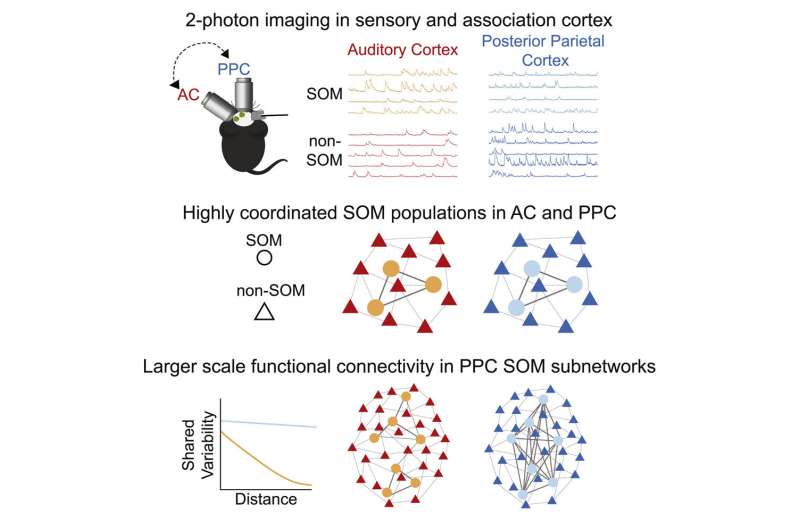Graphical abstract. Credit: Cell Reports (2022). DOI: 10.1016/j.celrep.2022.111319
The brain's cerebral cortex is made up of distinct regions involved in myriad processes, from sensory perception to cognitive functions like memory, attention, and decision-making. University of Pittsburgh neuroscience researchers have found that the properties of one neuron subtype—somatostatin neurons—are specialized in different subregions of the cortex.
The researchers set out to determine whether somatostatin neurons play similar or different roles in the auditory cortex, which is responsible for processing sounds, and the posterior parietal cortex, which is responsible for integrating sensory information to form perceptual decisions and guide behavior.
The researchers discovered that in both regions, when somatostatin neurons became active, other nearby somatostatin neurons tended to become active as well. But the distance over which somatostatin neurons shared activity expanded in the posterior parietal cortex. The study was published Sept. 6 in Cell Reports.
"Local networks in the cerebral cortex are comprised of excitatory and inhibitory neurons that interact to process incoming signals. Somatostatin neurons are one subtype of inhibitory neurons, which are known to shape the activity patterns of other nearby neurons," said senior author Caroline Runyan, assistant professor in the Department of Neuroscience in the Kenneth P. Dietrich School of Arts and Sciences.
"The results suggest that although cortical circuits in different regions are comprised of the same general cell types, the ways that these neurons interact as populations may be specialized for a brain region's processing goals, such as for sensory processing or for holding information in memory," Runyan added.
Christine Khoury, a 2022 Ph.D. at Pitt, postdoctoral associate in Runyan's lab and the first author said what caused her, Runyan and lab technician Noelle Fala (a 2020 Pitt graduate) to compare cell-type-specific activity across the cortex.
"SOM neurons and spatial patterns of neural activity have been studied extensively in sensory cortex," said Khoury, who also works in the Pitt Center for the Neural Basis of Cognition. "While many properties do generalize across cortex, it is important to find points of difference, which can help us understand how the activity of distinct regions is tailored to specific cognitive processes."
Tracking the inhibitory population activity in both the sensory and association cortices, the co-authors were able to perform two-photon calcium imaging and label these somatostatin (SOM) neurons in both areas. They also scrutinized activity in neurons that did not contain SOM. Put together, they said, the results suggest "in general, SOM neurons act locally as highly coordinated subpopulations throughout the cortex, whether involved in processing sensory information or forming perceptual decisions, but local networks are scaled to suit the different processing goals of different areas of the brain."
More information: Caroline A. Runyan, The spatial scale of somatostatin subnetworks increases from sensory to association cortex, Cell Reports (2022). DOI: 10.1016/j.celrep.2022.111319. www.cell.com/cell-reports/full … 2211-1247(22)01143-3
Journal information: Cell Reports
Provided by University of Pittsburgh
























